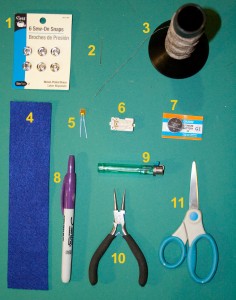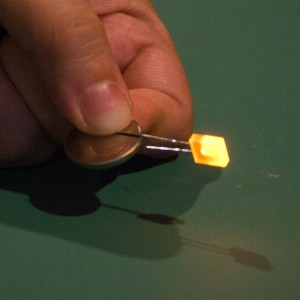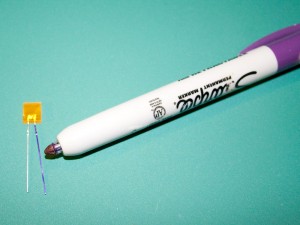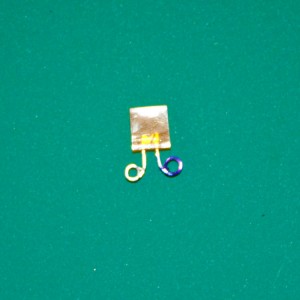Tutorial: Sew a Simple Circuit
One of my most recent crafty endeavors has been exploring the wild world of soft circuitry. It’s been a fun fusion of two things I love, crafts and science. While the craft part is pretty straight forward, the science end of things has been more of a challenge. Before working with sewable circuits, I knew very little about electricity – sure, I’d connected circuits before, made a lemon battery, and had a general layman’s understanding of electrons, but I’ve learned a whole lot more working on a few basic projects. The little I’ve learned about how electricity works was also helpful when Bug and I rewired the studio – we replaced existing wiring, hooked up new outlet boxes, and worked with conduit – it was easier than I expected!
In the interest of getting on with an already lengthy tutorial, I’ll post more about soft circuits in a future post. For now, enjoy these instructions for how to sew a simple circuit bracelet (or Power Cuff if you’re selling boys on the idea!). Please let me know in the comment sections if there are any instructions that are confusing (or flat out wrong!).
Materials and Tools
1. Sew-On Snaps- Make sure they are metal and not coated with paint, they need to conduct electricity. Magnetic snaps would also work – Available at craft stores or here.
2. Needle – Needs to have a relatively small head – Available at craft stores.
3. Conductive Thread – I’ve been using the 4ply conductive thread- Available at SparkFun.
4. Strip of Felt – Feel free to use another sewable, no-conductive material or fabric. Felt is easy because it doesn’t fray and is easy to stitch into – Available at craft stores.
5. LED – Most kinds should work, make sure they don’t need more than 3volts of power. I like to use the flat, rectangular LEDs for this project because they don’t stick out too much – Available here or in larger quantities here.
6. Surface Mount Battery Holder – Order this part from SparkFun, not all surface mount battery holders are sewable, this one is! – Available at SparkFun
7. Battery – CR2032 Lithium 3Volt Battery – Available where ever batteries are sold (I’ve seen ‘em cheap at IKEA and you can order them here).
8. Sharpie – Preferably a colored one.
9. Lighter – Optional, for burning ends of thread, I suppose a match would also work.
10. Round Nose Pliers – Typically a jewelry tool, small needle nose pliers would also work – Available at bead stores, most craft stores, or here.
11. Scissors – for clipping thread
Optional Materials:
Needle Threader – The conductive thread can be tricky to get through a needle and a needle threader is particularly useful for kids – Available at craft stores or here.
Electrical Tape – To tape the battery in place, especially in light of this scary article about kids swallowing these batteries – Available at any hardware store, most grocery stores, and some craft stores.
Alligator Clip Cables – Great for testing the project along the way. If you follow these steps exactly, you shouldn’t have anything go wrong, but it’s always nice to test that you’re wiring it up correctly before you sew it all together (trust me!). Also, if you’re planning to work with soft circuits in the future, you’ll definitely need a few sets of cables. – Available at Radio Shack and here.
IMPORTANT
By follow these instructions you should create a working circuit (which means that the LED will light up once the bracelet is snapped together). Because you’ll be stitching a circuit, it does matter that you stitch from one component to another in the exact order mentioned. There can’t be breaks in the thread in the middle of any two components that need to be connected. Also, crossed threads will create a short (and the light won’t go on or the battery will be drained). Follow the instructions carefully and be aware of what side (negative/positive) you are working with. Ultimately, negative will connect with negative, and positive will connect with positive.
CHECK YOUR BATTERY AND LED
Before you get too far into this project, you should probably make sure that your LED and battery work. This is pretty easy to do before you sew everything together.
Identify the positive lead (the little wires that look like legs on the LED are the leads) – it’s the longer of the two wires. Now find the positive side of the battery (it should be labeled with a +). Place the LED over the battery so that the positive lead is touching the positive side of the battery, and the negative lead is touching the negative side of the battery. The LED should light up – if not, your battery might be dead, your LED might be bad (not very likely), or yer doin’ it wrong (make sure the leads are only touching the corresponding side of the battery and not accidentally touching the opposite side).
PREPARING YOUR LED
Before you start sewing, you need to wrap the leads of the LED into circles so that you’ll be able to easily sew the LED onto the felt. Grab the Sharpie, LED, and round nose pliers.
Identify the positive wire on your LED – it will be the longest of the two leads. Mark it with a Sharpie.
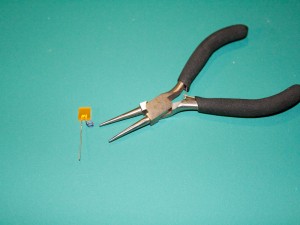
Using your round nose pliers, curl the leads into circles. Make sure the leads don’t cross or touch each other.
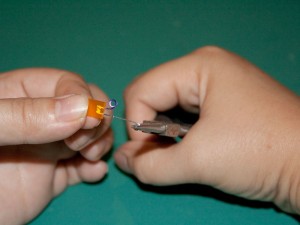
By bending the straight leads into circles, you now have something to sew through so that the LED will stay on your cuff.
Now your LED is ready to be sewn on! Take note of where your labeled positive lead is – we’ll start from that side when we start stitching.
SEWING THE POSITIVE LEAD TO THE BATTERY
Thread your needle with a length (about 18 inches) of conductive thread and tie a knot at the end. (When conducting this activity with kids, you can double string your needle and tie both ends together in a knot so that the thread won’t keep falling out of the eye of the needle.)
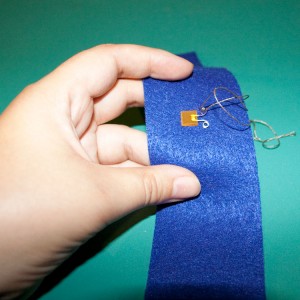
Place your LED in the middle of the felt cuff and begin sewing it on working only with the positive lead. Loop up through the circle a number of times being careful to pull your thread tightly in order to create a good connection between the LED and the conductive thread.
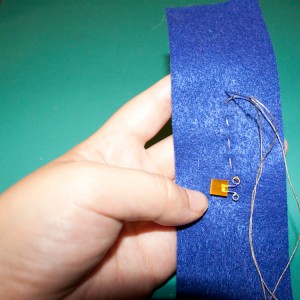
Once you’ve stitched around the positive side of the LED, begin stitching out towards the end of the felt. Use a simple straight stitch (also called the running stitch, here’s a video tutorial). Sew until the last stitch is approximately at the bottom of your wrist when you wear the cuff like a watch (put the LED in the spot where the watch face would go).
Make sure your last stitch is coming out the bottom of the cuff (the opposite side from the LED).
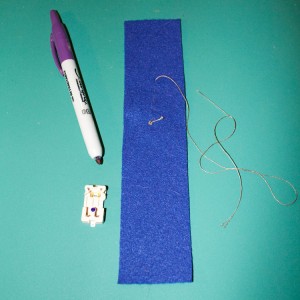
Take your battery holder and mark the positive end with your Sharpie. If you’re using the SparkFun battery holder there should be a little tab and some tiny negative and positive signs. End nearest the plastic tab is the positive end. Mark it with a dot.
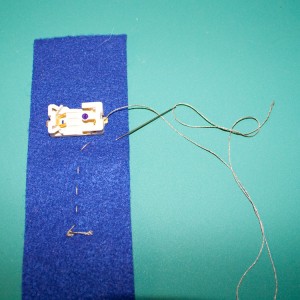
VERY IMPORTANT: You’ll be sewing the battery holder onto the bottom side of the cuff (the opposite side of the LED). If you haven’t already, flip your cuff over so you are working on the bottom side.
Start stitching through the hole in the battery holder closest to the positive side. Stitch up and down through the hole and the felt until it’s secure (you’ll probably only be able to pass the needle through two or three times as the hole is very small). Again, make sure that your stitches are tight and that the thread makes good contact with the metal tab on the battery holder.

Tie a secure knot in the thread and clip your thread leaving a tiny tail.
You’ve just connected the positive side of the LED to the positive side of the battery holder!
SEWING THE NEGATIVE SIDE OF THE BATTERY HOLDER TO THE SNAP
Tie a knot at the end of your thread (or thread and knot a new length of conductive thread if you have less than a foot left).
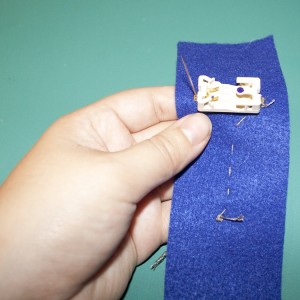
Stitch the other side (negative) of the battery holder to the felt. Just like before, make sure your stitches are making good connections with the metal tab and you’ll probably only be able to get your needle through the hole a few times.
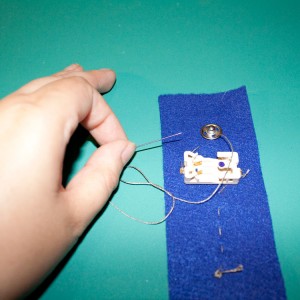
Once the negative side of battery holder is securely stitched, stitch a few stitches out to the end of the felt. This is where you’ll sew in one side of the snap.
Take one side of the snap (I used the pointy side that pops into the hole side) and stitch it to the felt.
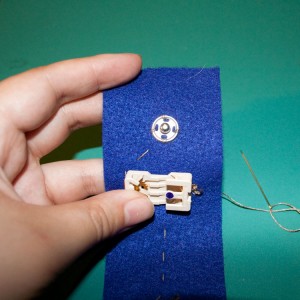
The snap will act at the switch for your circuit – when it is connected, electricity will pass through both sides of the snap and make the circuit complete. When the snap is disconnected, the circuit isn’t complete and electricity can’t flow through all the components.
Like always, make sure to stitch the snap in carefully, creating a tight connection between the thread and the metal snap.
Clip the end of the thread, leaving a short tail.
SEWING THE NEGATIVE LEAD TO THE OTHER SNAP
Thread a new length of conductive thread, making a knot in the end.
 Go back to the middle of your cuff – now you’ll be sewing the negative side of the LED out to the other end of your cuff.
Go back to the middle of your cuff – now you’ll be sewing the negative side of the LED out to the other end of your cuff.
Stitch up through the negative circle on the LED (remember, that’s the one that is not marked) and loop up and down through the felt and the LED legs a few times.

Now, stitch out to the other end of your cuff. Stop when you’ve reached the point where the other snap should go so that your cuff will fit your wrist.
Begin stitching the other side of the snap to the cuff – Make sure you are stitching it to the front (LED side) of the cuff.
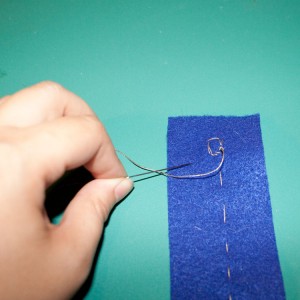 Stitch the snap in securely and clip your thread.
Stitch the snap in securely and clip your thread.
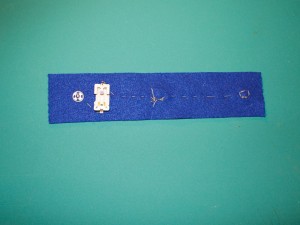 Double check your work. The back should look like this: One side of the snap, battery holder, stitches.
Double check your work. The back should look like this: One side of the snap, battery holder, stitches.
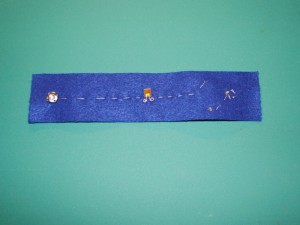 The front should look like this: Other side of the snap, LED, stitches
The front should look like this: Other side of the snap, LED, stitches
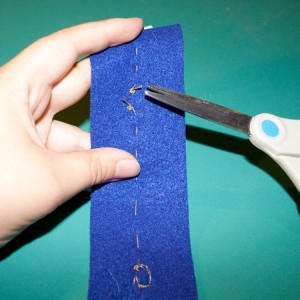
Check your whole cuff (front and back) for any ends of thread that may be touching another thread. All of these need to be clipped.
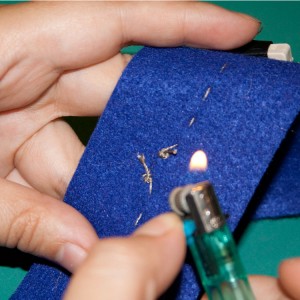
I’ve found that the conductive thread doesn’t knot super tightly, and on occasion, my knots have fallen out. To remedy this, I singe the ends of my thread where the knots are. Be very careful! The felt will melt (and you can easily burn a hole through your cuff) and obviously lighters are not toys!
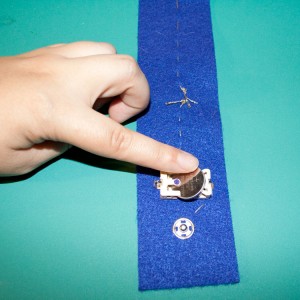
Now you can snap the battery into the holder. The battery is labeled – one side with a + the other with a – . In the SparkFun battery holders, the + side of the battery needs to face up. Slide the battery in and push it in place.
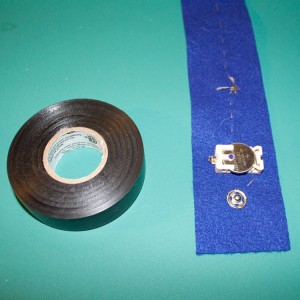
For added battery safety, you can tape the battery into the holder using electrical tape. Cut a two inch piece of tape and slide it underneath your battery holder with the sticky side facing up.

Securely tape around the battery holder and battery. If you need to change the battery in the future, you can just lift off the tape and install a new battery.
(You can tape the battery into the holder before the holder is sewn onto the cuff. That’s probably easier. To do this, tape your battery inside your holder before Step 8, and proceed to stitch it into place following the directions.)
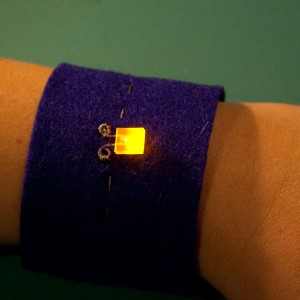
Now the moment of truth! When the snaps on your cuff are connected, the LED should light up.
If not (gulp!) you might want to check the following things:
- Is your battery dead?
- Is your battery installed correctly in the holder (+ side facing up)?
- Are all of your connections good (sometimes you have to jiggle things a little)?
- Is your snap conductive and well connected?
- Is the positive leg of the LED sewn to the positive side of the battery holder?
- Is the negative side of the LED sewn to a snap that, when connected, is sewn to the negative side of the battery holder?
- Make sure there aren’t any crossed or disconnected threads.
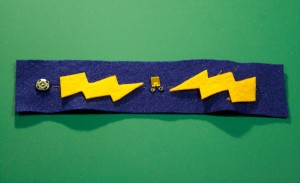
Hopefully it works great, and now you can decorate your cuff!
You can use embroidery stitches (with plain embroidery thread), beads, pieces of felt, sequins/rhinestones, feathers, fabric paint or pens, and many other decorative things.
Browse Timeline
- (older) Recipe: Cucumber Cups
- (newer) Tutorial: Make a Watermelon Whale!
Comments ( 1 Comment )
Thanks, Emily, for showing our girls this cool project! Keep em coming!

